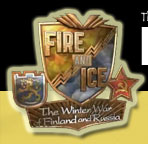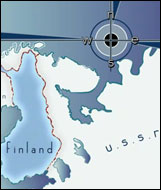

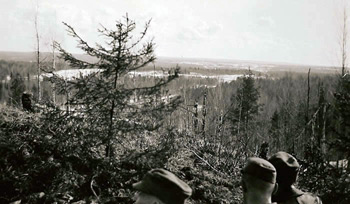
Brent Snodgrass
As was the case with Ladoga Karelia the Finns did not believe the Soviet attack in this region would be on the large scale that took place. The basic Soviet plan on this front was to split Finland in two as the main branch of this force was pushing to Oulu. The area is full of forests and offers very little in the way of roads and the roads in place were mainly smaller logging roads. These roads were winding and narrow and the Finns did not think the Soviets would commit strong armored forces to this region as these roads would be of little use. When today one speaks of the White Death in regards to Finnish soldiers it is in almost all cases related to what took place in the fighting in this region as it was this area where the Finn ski troopers were at their best and created the most issues for the Red Army. As the Soviets were forced to use the roads to move their men, armor, artillery, and like equipment, the Finns used the forests around the roads as staging points for attacks on the Soviet transports, columns, and networks. The Soviets were very spread out in this region as their columns stretched out for miles and miles, making them very inviting targets to the Finns. In some cases one Soviet division might cover 20 miles of these snaking roads. The Finns would use small numbers of men to attack these groups of Soviets on the roads. Attacking them in many cases began with a few fast mortar shots, followed up quickly by Finns on skis armed with submachine guns, and then after this (as depending on what type of attack it was) Finnish engineer troops would move in and form a breech in the column. This is how it went for the Soviets all along this sector and it was hell on earth for them. The Finns would appear out of nowhere, attack, and then the Finns were gone. Many of the Soviets felt the Finns were ghosts which added to the lore of the Finnish ski troops, as well as further adding fear in the Soviet ranks.
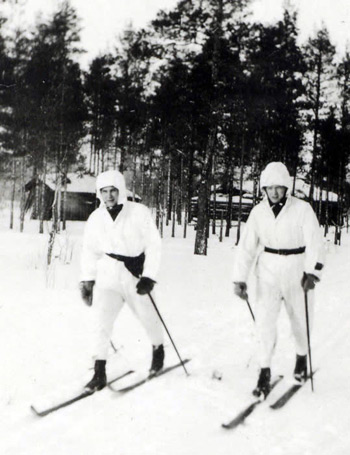
Finnish
Ski Troops
Marshall Kregel
The Finns all skied well as this was a way of life in Finland and, as such, these areas were easy for the Finns to move through. The Soviets could not move as freely as the roads were their only source of transport. Also the Finns knew how to handle the winter as winter was a form of life to those in Finland. The elements they knew how to deal with as cold and darkness were natural to them – these were not so natural to the Soviet soldiers. The Finns were dressed for this cold weather whereas the Soviets were not. Dealing with frostbite was a major problem for the Red Army. The Finns had small stoves used to cook with compared to the Soviets who had large field kitchens which the Finns attacked whenever they could. The Finns knew that hot food was life and if they could destroy the field kitchens, that meant the Red Army soldiers would only have cold rations. This did mean death to a great many of Red Army soldiers. The Finns also made use of winter whites – the Soviets had none so their uniforms tended to stand out. The Finns were hidden by the woods but the Soviets were not as they were on the open roads. The Soviets had no skis in this region and the soldiers of the area had no ski training. This was a very big disadvantage compared to the Finns. To say the Red Army soldiers in this region suffered is an understatement. Frostbite took entire limbs as well as hands, feet, fingers, and toes. Hunger killed many and others simply froze to death in the cold. It was a horrible way of life the Red Army was facing. The remaining Soviets had to deal with the fast moving Finns on skis who hunted the invaders down and killed them in mass. In short this was not a pleasant place for a Soviet soldier to be. The Soviets were also loud and noisy in their movements. Large amounts of soldiers, armored cars, tanks, and the like made a lot of noise which allowed the Finns to key on the Soviet movements. The Finns on the other hand were silent so they knew where the Soviets were but the Soviets almost never knew where the Finns might be until the Finns appeared with their submachine guns blazing.
Suomussalmi and the Raate Road
It is possible this
is the most famous of all the battles of the Winter War and it is
the one still studied today in war colleges
around the world.
The Soviet 163rd division was moved from its base near Murmansk and set to strike towards the center of Finland. Before the war, due to the heavy forests, Finnish intelligence had failed to see this division moving on roads Stalin had made in the Soviet side of the border. The goal was to take Oulu which would cut Finland in half and would also take the key railway routes to Sweden. The Soviets also had the 44th motorized division in the area to the south of 163rd with the 44th thought of as somewhat an elite division that was being held in reserve.
As the sector was not heavily guarded the first Finns to encounter these Red Army invaders were groups of border guards. The first border guard group facing this onslaught was only 50 men. The Soviets had three regiments of the 163rd on the move with two taking the Palovaara road junction while the third entered the town of Suomussalmi via the Raate Road. The Soviets troops on the road were also engaged mainly by Finn border guard units who, while outnumbered, were at least able to slow the advance. By December 7th the Finnish command understood the village would be lost so the Finns took out all the civilians that could be moved. The Finns then tried to set the village on fire but their efforts were only partly successful. By the end of the 7th one Soviet regiment from the north (Palovaara) was able to link and met up with a regiment coming from the Raate Road. At the same time he third Soviet regiment had secured the Lake Piispajärvi area to the north of Palovaara.
What was very clear now to the Finns was the fact that the Soviets had dedicated a large force to these attacks and the Finns were going to have problems stopping this large attack. While the Finns had fought hard and well, the simple fact of the matter was that the 163rd was a strong fighting force and the threat of the 44th division entering the fray was also looming. The Finns needed to take action and take this action quickly or this area would be lost.
Major General Tuompo – commander of the Northern Finland Group – felt the Soviets to the north of Suomussalmi on the Juntusranta Road were the greatest threat so this was the area he first sent the hastily gathered mix of Finnish troops. Finnish Independent Battalion ErP-16 moved to Peranka – about 25 miles north of Suomussalmi – moving into defensive positions on Lake Piispajärvi. The Finns were almost immediately attacked by the Soviet 662nd Regiment on the evening of December 6th as the Soviets had been ordered to take that area by nightfall. While the Finns were greatly outnumbered, within 24 hours the Finns had held and in fact seemed to hold the advantage. The Finns above the Palovaara road junction were under the command of Col. Paavo Susitaival (replacing a Finnish Major wounded on December 7th) and were designated Task Force Susi. The Finns were lucky in many regards as the 662nd had been stripped of some of its soldiers so only had 2,000 men in the battle. The Soviet soldiers were also in bad shape in regards to warm uniforms, boots, and rations since all seemed in short supply and this damaged their fighting ability. By the 14th the fighting seemed to be going the Finns way so the Soviets counterattacked. After some success these attacks were beaten back the next day and the Soviets gained nothing but higher losses. This attack in fact crippled the Soviet regiment and for the rest of the battle they were on the defensive for the most part.
As this battle to the north was taking place it became clearer to the Finns that the main Soviet forces were in the area of Suomussalmi and this arm of the force was the one that poised the greatest threat of breaking through and progressing towards Oulu. On December 7th Mannerheim sent JR-27 and its commander Colonel Hjalmar Siilasvuo to the area. Siilasvuo was an excellent tactical fighter and also a veteran of the 27th Jaeger Battalion in World War One. When Siilasvuo arrived he was informed JR-27 was the strongest Finnish force in region and as such it would be his job to destroy the 163rd Division. Siilasvuo had no anti-tank guns and no heavy weapons but he was armed with troops that were mobile and as many of his men lived in this area the land was known by his troops. Siilasvuo was also aware that the Soviet’s were somewhat in disarray as the northern and southern regiments were having issues with communications. He decided to take advantage of not only this but also that the Soviet troops on the southern region seemed to be moving slowly. His plan was a counterattack which would cut the large columns into smaller portions.
The attack began
on December 12th...
The
first task was to trap the 163rd inside of Suomussalmi so the Finns
made breaks in the Soviet lines creating
two effective road
blocks that would prevent supply to the 163rd. Siilasvuo’s
choice for these roadblocks were outstanding as they were flanked
by open frozen water – which meant the Soviets would have to
attack in mass over open ground to break these blocks. The main block
was located on a small ridge located between Lake Kuivasjärvi
and Kumasjärvi – about 6 miles southwest of the village.
The Finns also tried the same thing north of the village but the
Soviet troops were too strong and held out. The Finns in the north
were able to attack and harass anything that the Soviets tried to
move on this northern road and effectively cut off the village. For
two weeks the Finns attacked this region and were able to regain
most of the village and put the Soviets, who still outnumbered the
Finns, on the defensive.
The Finns were gaining troops in the region and on the 16-17th Task Force Susi was reinforced with 6th Bicycle Battalion (PPP6) under Major Jaervinen. The Finns also gained some artillery pieces on the 17th. With these new forces it was decided to attack the areas between Lakes Alajaervi and Kovajaervi. The Finns also raided Palovaara. PPP6 then attacked the Soviet forces in the Yli-Naeljaenkae crossroads area which lead to the fall of Vaaekio later that evening. By the 22nd the areas between Lakes Alajaervi and Kovajaervi were cleared and the 662nd was for the most part broken as a fighting force. All of these victories were fast and stunning in nature. On 25 December, Task Force Susi recaptured Haapavaara and by the 27th took Palovaara. Members of the 662nd began to turn on their own political officers as at least one was killed by his own troops.
By the 21st-22nd Siilasvuo was again reinforced and he was told his command would be of a division – so he had control of around 11,500 men and became the 9th Division. After these added troops arrived a Finnish attack was planned with the goal of destroying the Soviet troops in the areas of Hulkonniemi. The Finns began to look more and more to the South as the threat of the 44th Division was becoming more and more real. This Soviet division had been on the move on the Raate Road and if they could make it, the 44th could possibly break the Finns and save the beleaguered 163rd. Elements of the 44th were drawing near but the Finns had been able to fight a number of delaying actions stalling the Soviets. The Soviets were also hampered by the size of their force and the large amount of armor and heavy weapons they were transporting. The Finns attacked the advance guard of the 44th and then cut the road near Kokkojaervi on the 22nd. The 44th was unsure of how many Finns they were facing and decided to stop their advance and dig in. The Finn’s sudden attack, use of ski troopers with submachine guns, mortars, and snipers convinced the Soviet commanders they had been attacked by a massive Finn force, which could not be further from the truth. This action left the Finns the time to attack the 163rd as the Soviet division had just lost its best bet at escape. The 163rd was now in dire conditions and running low on everything including ammunition. As such they tried to break out of the motti that surrounded them. This took place on the 23rd-25th and it was a failure. The Finns held and the conditions inside the motti grew even worse. The morale of the Soviet division was almost in ruins as they felt they had been left for dead by their comrades. They saw no hope and from the north, Task Force Susi (now under Siilasvuo’s control), was further closing the gap – like a hangman’s noose.
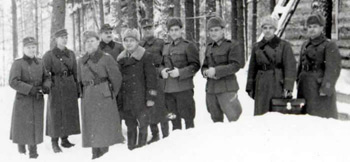
Marshall Kregel
On December 26th the Finns launched the attack
they hoped would wipe out the 163rd. The main attack would be toward
Hulkonniemi which
would break the 163rd Division perimeter. This attack would be supported
by an effort to cut the road to Harola to the North – then
the Finns would move into Suomussalmi and break the Soviet forces
in two. Siilasvuo would also launch supporting attacks with the rest
of the 9th division. The action put pressure on all sides of the
motti and those Soviets inside. This time of fighting was the worst
that had been seen as the Soviets knew they were fighting for their
lives. The Finns pressed and pressed against hard Soviet resistance
but by the 29th Suomussalmi had fallen. Many of the Soviet troops
ran in mass into the woods and frozen lakes. These soldiers were
hunted down by the Finns even though in some cases the Finns let
the stragglers leave as the Finns felt sorry even for the invaders.
On the 30th the action was for the most part a mopping up operation
as the Soviet division had been wiped out. There were over 5000 dead
Soviet soldiers just from the eastern edges of the road leading to
Suomussalmi to the northern end of Lake Piispajärvi. It is not
known how many Soviets died in the woods surrounding the area, nor
is it known how many did escape and retreat in panic towards the
Soviet Union border.
Now the Finns were faced with the 44th Division whose advance troops were only six miles away from Suomussalmi. The Finns had been, and still were, in shock about just how passive the 44th had been and now the Finns were going to make the Soviets pay for this mistake. While the 44th was thought of as an elite division they were much more suited for a war in central Europe. The area of Finland they found themselves in was poor tank country and these surroundings seemed to have left the 44th in a state of shock.
On the 31st the Finns scouted the 44th in the Haukila area and they found that this was largest strongpoint of the division. Most of the division's tanks and artillery was strongly entrenched in a two-mile sector just east of the roadblock. These forces were the 25th Rifle Regiment, 2/146th Rifle Regiment, the 122nd and 179th Artillery Regiments and the 312th Tank Battalion. The 44th was stretched over 20 miles at this point so the Finns decided to attack about 15 or so miles east of the front of the column. This in effect cut the 44th off from escape as they could not move forward nor backwards since they were stuck on the roads due to their tanks and equipment. There was no place they could go. The Finns followed their standard motti practices and started to chip away at the Soviet forces. The 44th was suffering now: no hot food as the Finns targeted field kitchens, no warm clothes, no boots, and low ammo – all were factors in this suffering. By the 6th of January the Soviets were in dire straights and needed to do something to break out of this position but all their attempts failed. They even attempted to send horses in mass through a minefield and have the horses run through the Finn lines but all of the animals were killed by mines or Finnish machine guns. Division Commander Vinogradov issued an order on this day that it was now every man for himself, meaning the soldiers of the division should flee to the Soviet Union in any manner they could. This caused a panic and the Soviets killed many of their own men with many even trampled to death or being run over by tanks. By the end of the day, the 44th Division lost over 1000 men (dead) 2200+ wounded and 2,250 MIA, although the real numbers are still not known as for years the Soviets claimed to have lost less than 300 men in these battles.
Some of the key points of the battle –
General Notes On This Battle And The Smaller Battles Within The Larger
-
The Soviets did attack in large numbers and the troops had modern equipment however these items did them next to no good in this battle. In fact all the heavy items made the Soviets depend on the roads and this made the Finn attacks easier and it made it easier to encircle the Soviets.
-
This is a great example of how Finnish mobility caused issues. The Finns were able to move and the Soviets were not. The Finns also created what were known as “ice roads” which they traveled. These smaller-cut roads allowed the Finns to sneak up to Soviet positions as in some cases the ice road ran next to (but hidden from) the main roads the Soviets were on. These ice roads are important to mention and were used in both the north and the southern ends of this battle.
-
Good example of poor leadership and planning by the Soviets. The idea of attacking in this area with all the burdens these divisions carried were doomed to fail. On paper the plan looked good but it was not too practical in real life. Also the actions of the 44th are somewhat amazing as they seemed to play right into the Finns hands. The Russians exhibited poor leadership and poor planning.
-
KEY NUMBERS - 27,500 Soviet dead, 43 destroyed tanks, a great number of artillery pieces lost, trucks and the like as well. The booty the Finns took here is amazing: Finland captured 65 tanks, 437 trucks, 10 motorcycles, 1,620 horses, 92 field guns, 78 anti-tank guns, 13 anti-aircraft guns, 6,000 rifles, 290 machine-guns. All of these were added to the Finnish war effort. Finns had 900 killed and about 1,800 wounded in the fighting.
-
Division Commander Vinogradov and three other higher officers of the 44th were executed by the Soviets.

